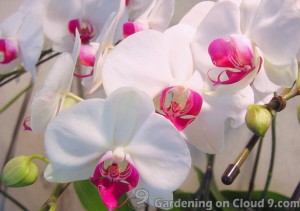Phalaenopsis orchids are very suitable for city dwellers who have limited space and no gardens. Since Phalaenopsis orchid is quite easy to grow and generally likes the light and temperature condition of our homes, it is an excellent choice for the first time orchid growers, as well as indoor gardeners.
Below are some tips of growing Phalaenopsis orchids.
Light
Phalaenopsis orchids do well near bright window, without direct sunlight. If we place our Phalaenopsis orchids indoor, an east facing window is ideal, while shaded south or west facing windows are also acceptable. I grow my Phalaenopsis orchid outside my north facing balcony and it grows very well. If we grow our Phalaenopsis orchids outdoor under direct sunlight, the growing area will need to be covered with 70-75% shade cloth.
Let the foliage be your guide. If there is excessive dark reddish pigmentation on the leaves, the leaves probably have been burnt. In this case, we should move our orchids to an area with less sun exposure. On the other hand, if the leaves are long and floppy, the Phalaenopsis orchid may not be getting enough light.
Watering
If we grow our Phalaenopsis orchids in pots instead of by hanging, the orchid roots will not be exposed to the air as much, and hence will dry up slower. We should water our Phalaenopsis orchids only when the roots are dry (but don’t wait till bone-dry). Be aware not to overwater our orchids, the roots will rot and the orchid will not survive. In addition, water our Phalaenopsis orchids early enough in the day time so that the leaves will be dry by nightfall. It is especially important not to let water stay in the crown of the orchids for this will lead to crown rot.
Fertilizer
Phalaenopsis orchids do well with regular fertilizing, yet will suffer if over-fertilized. As a rule of thumb, fertilize our Phalaenopsis orchids every 10-14 days with a balanced formula like 20-20-20 in only half the strength as instructed on the fertilizer package.
Temperature
Phalaenopsis orchids grow well in temperature between 20-30 degree Celsius (65-85 degrees Fahrenheit), and the orchids will stop growing when the temperature is above 35 degree Celsius (95 degrees Fahrenheit) or below 10 degree Celsius (50 degrees Fahrenheit).
Humidity and Ventilation
Phalaenopsis orchids love high humidity, around 70%. Yet, the moth orchids also need good ventilation and air circulation in order to grow well, particularly during very humid conditions when fungal and bacterial disease can be a real threat. In this case, an oscillating fan that moves air constantly at low speed will be very helpful.




I love Phalaenopsis orchids. There are so sweet and pretty. They like our humid climate here.
This is a great guide, Sandy. Especially the part about light levels. I think that is where most orchid growers fumble when it comes to the different species.
Is that photo of one of your phals? It is lovely!
Hi Sunita, thanks for dropping by! N yes they are my phals. I love my orchids, they fits the condition of my home very well 🙂
L love this site thanks for being there l love Phalaenopsis orchids l have 16 growing right now all in bloom l received 2 this week in crystal soil can l leave them in crystal soil?
Hi Manuela,
Orchids are air plants. They need a loose, easily drained substrata for support. So crystal soil is not a good potting mix for orchids. For the sake of convenience, I would suggest you to buy some ready-mix mediums for orchids that are available in nursery and home center.
I just received the most beautiful orchid plant, actually two. They are in a white picket fence basket with a trellis. My question is, how do I know what materials they are planted in? I’m assuming potting soil. How can I tell if roots are dry?
Still awaiting comment on soil
I grow my Phalaenopsis and Dendrobium orchids outdoors. I grow them in clay orchids pots filled with sphagnum moss. I live in Southwest Texas (Del Rio), where the summers are brutally hot, where it rarely rains and the winter does get below freezing. Though it doesn’t stay below freezing on a regular basis. It was my first summer here, so I wasn’t sure how they would do outdoors. It is a desert type environment, however it can get quite humid here. Last Winter I bought some beautiful moth orchids at the grocery store dirt cheap. When winter was over, I moved them outdoors in full shade for about a week, and week by week moved them into areas that received more sun. In about a month they were fully acclimated to the outdoors. The summers here are brutal. They got so used to the climate, that they received about two hours of full afternoon sun each day, in the middle of summer. They seemed to love it, as they are growing furiously. The blooms on the moth orchids lasted for months. One plant had blooms that lasted the entire spring and summer. I had to water almost daily in the full heat of summer. Now that fall is approaching, all my orchids have new spikes emerging. They are not as delicate as some may make them out to be. Very tough plants when acclimated to the sun slowly. I will have to bring them in for the winter however. Don’t want to experiment to see how much they can handle the frost. I fertilize them about every two weeks, and now that it’s cooler, water them about every three days. I’m wondering how they’re going to handle being brought indoors this winter.
Hello
I have a phalaenopsis Orchid when I first received it I had beautiful deep pink blooms I’ve had it for two years the stem that held the blooms is dried out beige/tan color however the leaves that sit at the base are beautiful deep green that keep producing deep green leaves How do I get a stem to grow to produces blooms?
awaiting a reply to aforementioned question